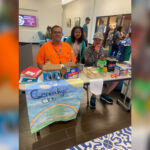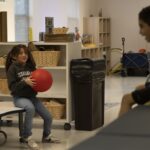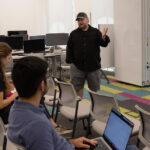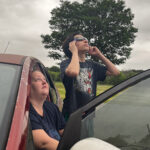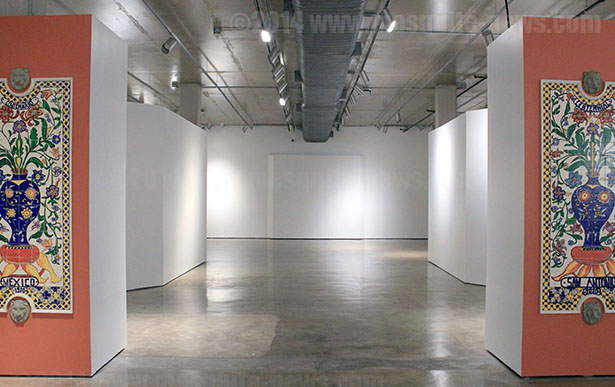
By Lorie Hidalgo
Texas A&M-San Antonio celebrates its first art exhibition entitled “Contemporary Latino Art: El Corazon de San Antonio” in May, displaying work of local, Latino artists.
The exhibition opens to the public May 9 through the end of August at the university’s Educational & Cultural Arts Center (ECAC), 101 S. Santa Rosa Ave.
Alicia Viera, director of cultural programs, said the curatorial team has begun reviewing hundreds of submissions ranging from paintings, sculptures and performance art.
Viera said she was not at liberty to identify other members of the curatorial team who are making the selections but plans to release more information closer to the launch of the exhibition.
The team will narrow down selected artworks as well as finalize an education model to make the work accessible to the campus and city.
The exhibition represents the university’s first collaborative showcase of local artists and their work since the university negotiated a lease of the former Alameda Museum through the city of San Antonio, which was unanimously approved by city council in 2012.
Marilu Reyna, associate vice president of institutional advancement and university communications, who actively participated in the exhibition planning, said the university felt passionate about making the first exhibition meaningful by creating ties between the center and local residents.
Reyna and Viera emphasized the university’s desire to build and sustain a strong connection to the artists and the community.
Building a home
The former Museo Alameda was the first formal Smithsonian Institution affiliation under the Affiliates Program in the nation, but closed in September 2012 following financial struggles.
The museum was $1.5 million in debt and received a $450,000 bailout from the city that year, as it struggled to stay open but never drew the crowds to keep it afloat.
The university, wishing to begin an arts and education center downtown, acquired the former Latino museum building in 2012 when the facility closed. In a collaborative agreement, the city is contributing $450,000 in funding for the next three years.
In May 2013, the university named its downtown center “Casa Rosa;” however, the name was removed because of trademark issues.
Reyna told The Mesquite last semester that the university expected to announce a new name that fall, but failed to do so.
In an interview Monday, Reyna said a new name will be determined by a focus group assembled by the university.
In August 2013, the university announced Viera as the newly appointed director of cultural programs for the Educational & Cultural Arts Center. She has a three-year contract, paid for by the City of San Antonio’s Department for Culture and Creative Development, as part of the collaborative agreement.
Viera, who feels strongly about the educational aspect of the artwork, is a Ph.D. candidate in Art Education/Arts Administration with the Department of Art Education in the Florida State University College of Visual Arts, Theater & Dance.
Engaging the audience
Exhibitions traditionally only present the art to the guest and do not give further detail other than an artist statement and the basic information of their style.
“Contemporary Latino Art: El Corazon de San Antonio” represents a new technique to engage both devoted art goers and those who lack regular exposure to the arts.
The intention is to allow guests to feel comfortable, build a connection and interact. Curators encourage guests of the exhibition to engage with the art through social media and hands-on experiences.
The exhibition also plans to hold educational programming and events at the ECAC. Rosario Torres-Raines, education coordinator for the ECAC and sociology professor, was not available to comment before deadline.

Viera said the style of the exhibition creates an educational and visitor friendly environment, allowing the viewer to make a connection with art instead of just viewing and not understanding what it represents.
The idea is based on a curatorial model called Supported Interpretation (SI) developed by Dr. Pat Villeneuve, professor and director of Arts Administration in the Department of Art Education at Florida State University.
Dr. Villeneuve, a proponent for inclusive, visitor-centered exhibitions says “general education in the United States has not given people the skills to make sense of art in satisfying ways.”
Instead, exhibitions should “encourage individualized and active learning” by allowing guests to interact with the artwork.
Reyna said the idea for this type of exhibition came natural to those involved in the planning stages because of the university’s strong ties to its local artists, including some South Texas art that is on display at the Main Campus Building.
“If you look at the university building itself you can see that we display local artists there already. Dr. Ferrier felt very passionate about highlighting local artists even before having what is now the former Alameda Museum. This is a way to bring the community back together: we don’t want to leave out anyone, especially our local artists,” Reyna said.
Although submissions for the May exhibition closed, the online submission process continues to accept new artists profiles for future exhibitions. Viera reviews and selects applicants for exhibitions.
As of now the profile is held in a private database where only those directly involved in the development are allowed access. In the future, Viera said she would like for the artists and their profiles to be viewable by both those who are viewing submitted work and the public who views their work at the ECAC.
Viera said she made house visits to reach out to artists who were either unaware or unfamiliar with the online submission format.
“(Some) artists are not familiar with technology and so Alicia is making house calls and phone calls to make that personal connection to reach out and make the artist feel comfortable,” Reyna said.
Future Exhibitions
Future exhibits held by the university will share the same focus of the Latino artists that are local and also expand on the idea. Both Viera and Reyna mentioned that an arts program at the university would be beneficial for students and programming at the center.
Curators plan to expand their search from local artists to regional or international artists for future exhibits. This would allow for the school to expand exhibitions and programming.
“There are a number of ideas for future exhibits yet I can’t speak on those,” Viera said. “But the focus is on the Latino artists and
keeping it local, but the emphasis is on San Antonio and South Texas. We want to be situated in context and different things can happen in the future, but we are still discussing this.”
The exhibition welcomes not only traditional art enthusiasts but also the younger generation. The curatorial group’s intention with this exhibit is to engage a diverse number of people. The art that will be displayed spans generations allowing for many people to make a connection to the work. For more information on the exhibition and further details leading up to the opening ceremony, visit the Educational & Cultural Arts Center’s website.
Student Involvement
Viera and Reyna encourage and welcome students from A&M-San Antonio to participate in the exhibition.
Reyna said students can participate and become involved by volunteering during the opening and closing ceremonies, or becoming ambassadors, tour guides or liaisons.
“We want to have passionate people who are interested in this place and what it has,” Viera said.
For more information on volunteer opportunities, contact Alicia Viera at 210-784-1105, or Marilu Reyna via email or phone.


